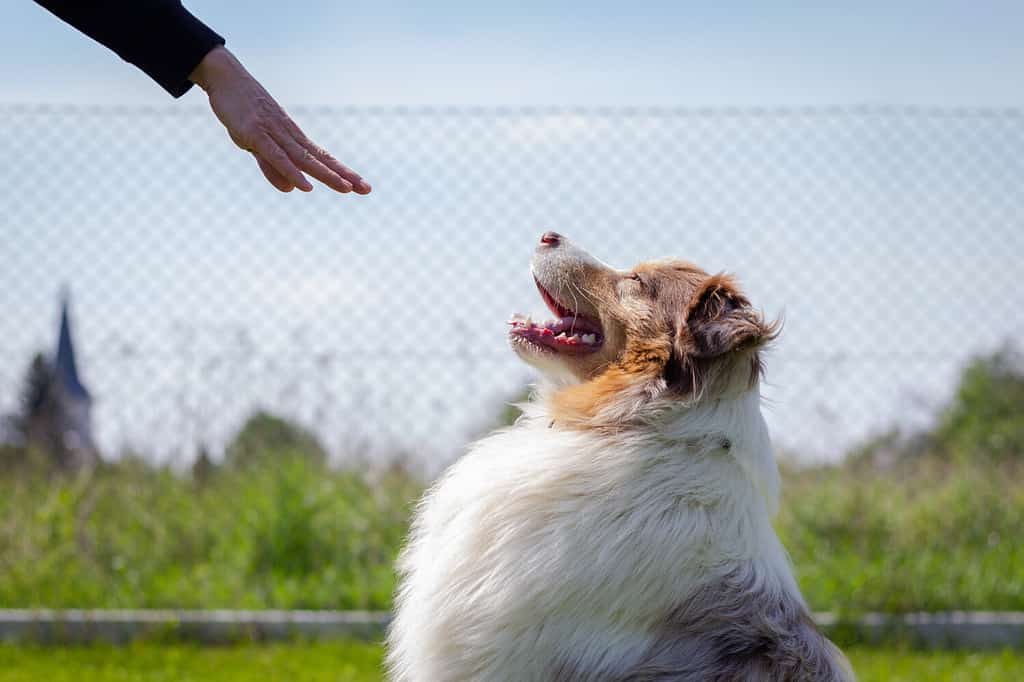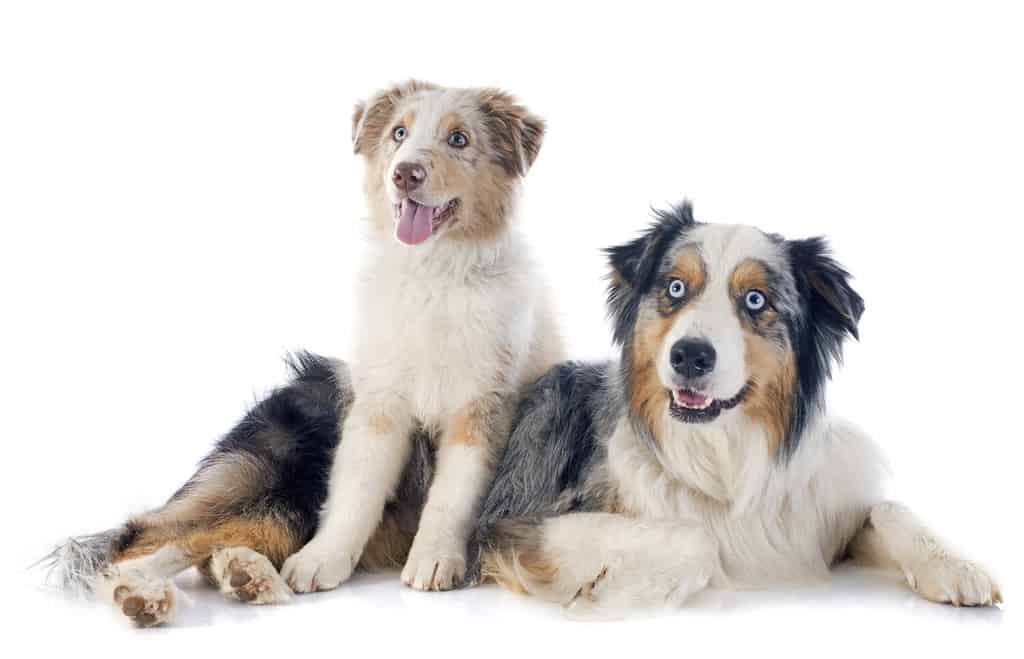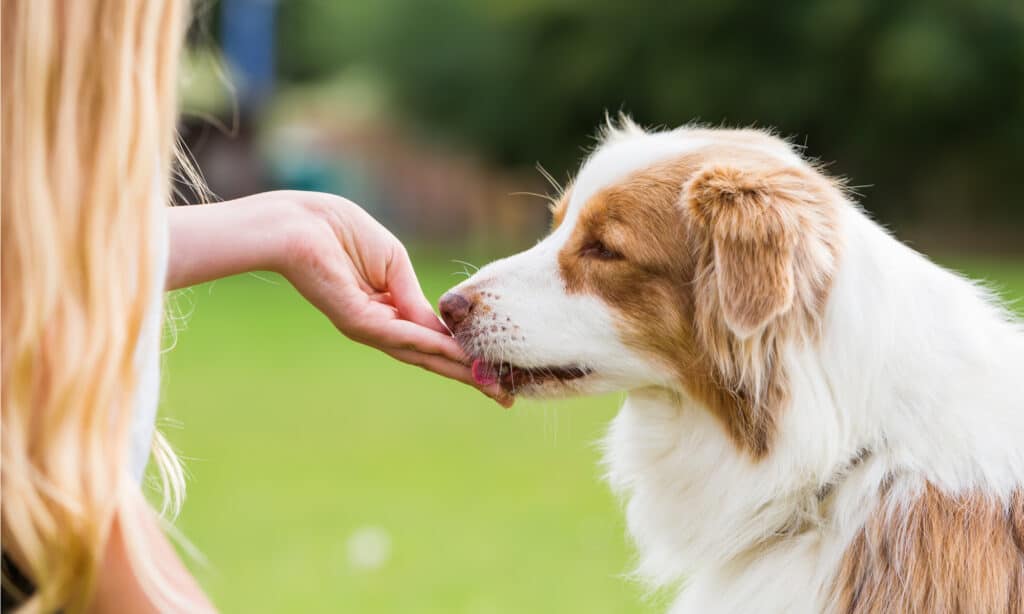Training your Australian shepherd is a relatively easy process because these dogs are extremely bright. However, their intelligence can cause trouble, as can their high energy levels, herding instincts, and guarding tendencies.
You should begin training Australian shepherds as soon as you bring them home, starting with the basics like learning their name and potty training. Work on bite inhibition early on by redirecting teething and nipping to toys.
In this guide, we’ll discuss everything to know about training your Australian shepherd, from cues to start with to common training mistakes.
Are Australian Shepherds Easy to Train?

Basic cues like sit are a great place to start when training your Aussie.
©encierro/Shutterstock.com
Australian shepherds are very eager to please but also high energy. They’re easy to train if they’re getting enough exercise, but you may run into some common issues. These include chasing and nipping heels, which are both a result of their herding instincts.
Aussies without enough exercise or mental stimulation may seem like difficult dogs. They’re likely to be destructive and bark excessively. However, this is a result of their needs not being met. It’s important to consider whether you can give an Australian shepherd everything they need before adoption, as they’re higher maintenance than most dog breeds.
How Fast do Australian Shepherds Learn?
Aussies tend to learn new cues fairly quickly but do require repetition, especially when they’re young. Begin training simple cues and manners when you bring your puppy home but have patience.
Like all puppies, they’re going to struggle with impulse control and likely won’t focus on training for long periods of time.
Keep it brief and fun. Use lots of tasty treats and turn training into a game rather than a chore. Don’t punish them for getting things wrong, as this makes training a negative and dreadful experience.
Whenever possible, end on a high note before you or your puppy becomes bored or frustrated.
Potty training typically takes four to six months, but you can prevent accidents indoors by sticking to a routine and taking your Aussie out to potty often. Remember that puppies under six months can only hold their pee for around one hour per month of age.
Avoid making them wait as long as possible for their age, as this can lead to accidents, and remember that every dog is different. Like people, some will have a harder time holding their bladder than others.
Most Aussies will master basic cues by around six months old and should also have adjusted to your home and routine at this point as well. You may see some regression around adolescence as your pup begins to defy the rules and push your boundaries. Stick with it and have patience, knowing that this is a natural phase of their development.
When your dog is around one to one and a half years old, you can begin settling into an adult routine, including longer runs and other physical activities that are too taxing on puppies’ joints. They’ll also have more impulse control and the ability to focus at this age, which can make training sessions more fun for you both!
How to Discipline an Australian Shepherd

Positive reinforcement is one of the best training techniques and can include rewards like praise, treats, and play.
©Christian Mueller/Shutterstock.com
Avoid trying to be the alpha dog, dominate your dog, or inflict harsh punishments for misbehavior. Aversive tools and methods should also be avoided in favor of humane and science-based training methods.
Here are some ways to raise a well-behaved Australian shepherd:
- Make sure they’re getting enough exercise and mental enrichment. An Australian shepherd is unlikely to behave if they’re full of energy, so this is the first and most important step.
- Manage your dog’s environment. Put away dangerous items and anything your dog might chew. Use baby gates to block them from running out of doorways if needed or to keep your pup from jumping on guests. You want to set them up for success whenever possible and avoid them practicing poor behaviors.
- Use positive reinforcement. Lots of praise and treats should be given when your Aussie does something you like. When they’re first learning how to behave, reward even baby steps.
- Don’t give attention to bad behaviors. Sometimes, it’s best to ignore misbehavior by walking away or simply handling the situation without comment. Examples include puppies that bite your hand or pee indoors.
- Redirect your dog to proper outlets for their behavior. This can mean giving your biting puppy a toy to chew or directing herding behaviors toward a herding ball instead of other pets or people.
Socializing Your Australian Shepherd

Exposing your Aussie to a variety of people and situations sets them up to become well-behaved adult dogs.
©Izemphoto/Shutterstock.com
Socialization is one of the most important aspects of raising a dog. It doesn’t only mean meeting new people or dogs directly but also learning how to behave around them without interacting. An example is learning to pass other dogs on walks without lunging or barking.
You’ll also want to introduce your Aussie to different environments, sights, and sounds. Puppies who hear fireworks sounds starting at a low volume will be less afraid when they hear them outside, for example.
Lastly, make it easy for your veterinarian, groomer, or your future self to handle your Aussie by getting them used to having their mouth, paws, and tails touched, their nails clipped, their coat brushed, etc.
How to Train an Australian Shepherd Not to Bite
Australian shepherds commonly nip the heels of people or other animals in an attempt to herd them. We have to remember that, for most of their history, this is exactly what they were bred to do!
For this reason, it can be difficult to train out–especially without giving them another outlet for their instincts.
The good news is that most Aussies won’t bite hard, but their nips can still hurt–especially if you have children or smaller pets.
Here are some ways to curb your Aussie’s biting:
- Provide outlets for their herding instincts. Playing with a herding ball in the backyard is a great alternative! You can also give them outlets for chasing, such as flirt poles and games of fetch.
- Stop playing when they bite. If your Aussie bites while you’re running around or playing with them, immediately stop and walk away. This teaches them that the games only continue if they play nicely!
- Train “leave it.” This is a vital skill for any dog. With an Aussie nipping, “leave it” may look like ignoring children who are running around instead of chasing or nipping. Begin with things that are easy to ignore and high-value treats, and work your way up to bigger distractions.
- Manage the environment. You may need to keep your Aussie in a playpen when kids are visiting or separate your own children from the puppy until they learn not to bite people. You might also need to keep them away from other people or animals while they’re running, as this is often when chasing and nipping happens.
- Muzzle train your dog. Any dog who nips or bites should be muzzled in public so that they don’t bite strangers, especially any children that might run by on your walks. Make it a positive experience for your Aussie so that they don’t learn to fear the muzzle or see it as punishment.
- Seek professional help. If you cannot get your Aussie to stop biting or you think they’re showing true aggression, reach out to a force-free trainer or dog behaviorist who’s experienced with aggressive dogs.
Australian Shepherd Cues to Teach First

Puppies should begin with basic cues like pottying outside, sitting, and lying down.
©cynoclub/Shutterstock.com
When you first bring your puppy home, you’ll want to work on potty training, basic cues, and leash manners.
You can’t expect perfection at this age. It’s mostly practice to build a good foundation for future training. It’s also practice for you and other humans in the family as you get used to training a dog, especially if this is your first puppy!
Supervision is especially important to keep your puppy from peeing indoors or practicing other problem behaviors like chewing inappropriately.
Work on cues like sit and down first, Teach your puppy their name, and practice recall in distraction-free environments.
Work up to safety cues such as stay, leave it, and drop it. When possible, teach your puppy through play! For instance, you might teach drop it while playing fetch.
You’ll also want to teach speak and quiet cues fairly early on to manage excessive barking, which Aussies can be prone to.
Other Helpful Cues for Australian Shepherds to Know
Australian shepherds are intelligent dogs that succeed at many tasks, including service work. Almost anything you want to teach, they can learn.
You may want to teach only useful cues, like finding your phone, putting their toys in a basket, or grabbing a bottle of water for you. Or, you might prefer silly and fun tricks such as waving hello, spinning in a circle, and bowing to end the show.
Aussies can also excel at dog sports and advanced obedience. If you’re unsure of where to start, dog training classes can act as a guide. Begin with puppy training courses and move on to more advanced lessons as you and your dog gain confidence.
Common Australian Shepherd Training Mistakes

Providing plenty of rewards for good behavior lets your Aussie know when they’re doing right!
©Christian Mueller/Shutterstock.com
- Not providing enough exercise or mental stimulation. Remember that daily walks aren’t enough!
- Using aversive training methods or tools instead of force-free training methods which are more effective long-term.
- Not teaching a quiet cue to stop your Aussie from barking excessively.
- Purposefully training aggression or biting without experience or using poor training methods which can lead to fearfulness and indiscriminate aggression.
- Taking things away from your Aussie or messing with their food while they eat in an attempt to prevent resource guarding. This often does the opposite, making your dog insecure and more prone to guard their things.
- Not teaching alternatives to poor behaviors or praising good behavior, so your dog doesn’t know what they should be doing.
- Not managing your dog and their environment to prevent misbehaviors such as pottying indoors, door dashing, chasing, or nipping.
- Teaching cues with similar names like “sit down” and “lay down” instead of “sit” and “down.” Similar words can be confusing for dogs, and each cue should sound unique.
- Not understanding dog body language before introducing your Aussie to other dogs or making introductions too quickly.
The photo featured at the top of this post is © Christian Mueller/Shutterstock.com
Ready to discover the top 10 cutest dog breeds in the entire world?
How about the fastest dogs, the largest dogs and those that are -- quite frankly -- just the kindest dogs on the planet? Each day, AZ Animals sends out lists just like this to our thousands of email subscribers. And the best part? It's FREE. Join today by entering your email below.
Thank you for reading! Have some feedback for us? Contact the AZ Animals editorial team.






